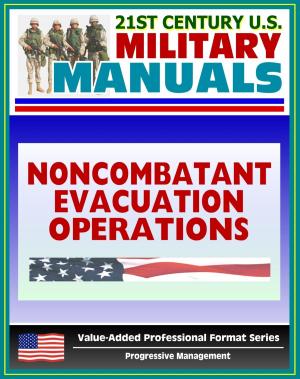Fire Weather (Agriculture Handbook 360) Part 1 - Guide for Application of Meteorological Information to Forest Fire Control Operations, Winds, Moisture, Temperature, Fronts, Thunderstorms, Climate
Nonfiction, Science & Nature, Technology, Fire Science, Science, Other Sciences, Meteorology| Author: | Progressive Management | ISBN: | 9781310994586 |
| Publisher: | Progressive Management | Publication: | September 28, 2014 |
| Imprint: | Smashwords Edition | Language: | English |
| Author: | Progressive Management |
| ISBN: | 9781310994586 |
| Publisher: | Progressive Management |
| Publication: | September 28, 2014 |
| Imprint: | Smashwords Edition |
| Language: | English |
Full document description: Weather is never static. It is always dynamic. Its interpretation is an art. The environment is in control in wildland firefighting. Free-burning fires are literally nourished by weather elements, atmospheric components, and atmospheric motion. Outguessing Mother Nature in order to win control is an extremely difficult task. We need to soothe her with understanding. We have attempted to present information in such a way that your daily and seasonal awareness of fire weather can begin with reliable basic knowledge. We have kept the use of technical terms to a minimum, but where it was necessary for clear and accurate presentation, we have introduced and defined the proper terms. Growing awareness of fire weather, when combined with related experience on fires, can develop into increasingly intuitive, rapid, and accurate applications. Toward this end, we have preceded each chapter with a paragraph or two on important points to look for in relating weather factors to fire control planning and action. The illustrations are designed to help you "see" the weather from many different locations. The illustrations should help you to evaluate fire weather in all of its dimensions, and simultaneously to keep track of its continually changing character. Topics include Foehn winds, convective winds, Santa Ana wind, Chinook wind.
CHAPTER 1 - BASIC PRINCIPLES - The primary causes of the actions, reactions, and interactions of the components of the atmosphere and the elements of weather need to be understood because the behavior of wildland fire depends upon them. CHAPTER 2 - TEMPERATURE - The continual changes in land, sea, and air temperatures from hot to cold during day and night and summer and winter affect fire-weather judgments and predictions. CHAPTER 3 - ATMOSPHERIC MOISTURE - The amount of water vapor in the air-the degree of "wetness" and "dryness" as a condition of fire weather-must be considered in all evaluations of wildland fire potential and control. CHAPTER 4 - ATMOSPHERIC STABILITY - The distributions of temperature and moisture aloft, although difficult to perceive thousands of feet above the surface, can critically influence the behavior of a wildland fire. CHAPTER 5 - GENERAL CIRCULATION - Large-scale circulation of air and moisture in the atmosphere sets the regional patterns for both long-term trends and seasonal variations in fire weather. CHAPTER 6 - GENERAL WINDS - An understanding of the mechanics of wind flow as measured and expressed in terms of speed and vertical and horizontal directions, both regionally and locally, are of extreme importance to the wildland fire-control man. CHAPTER 7 - CONVECTIVE WINDS - Local surface conditions resulting in the heating and cooling of the surface air cause air motions which can account for "unusual" wind behavior on a wildland fire. CHAPTER 8 - AIR MASSES AND FRONTS - Both warm and cold air masses, usually coincident with high-pressure cells, migrate constantly over areas of thousands of square miles. When they are stationary, fire weather changes only gradually from day to, day, but when they move and overtake or encounter other air masses, weather elements do change-often -suddenly. CHAPTER 9 - CLOUDS AND PRECIPITATION - Clouds, in both amounts and kinds, or their absence, are indicators of fire-weather conditions that must be evaluated daily. Some can locally forewarn fire-control men of high fire hazard.-Not all of them produce rain. CHAPTER 10 - THUNDERSTORMS - When a moist air mass becomes unstable, thunderstorms are likely. Their fire-starting potential and effect on fire behavior can be anticipated if the weather conditions, which produce them, are understood. CHAPTER 11 - WEATHER AND FUEL MOISTURE - The response of both living and dead forest and range fuels, the food on which wildland fire feeds, to atmospheric and precipitated moisture affect wildland fire prevention and control. CHAPTER 12 - FIRE CLIMATE REGIONS
Full document description: Weather is never static. It is always dynamic. Its interpretation is an art. The environment is in control in wildland firefighting. Free-burning fires are literally nourished by weather elements, atmospheric components, and atmospheric motion. Outguessing Mother Nature in order to win control is an extremely difficult task. We need to soothe her with understanding. We have attempted to present information in such a way that your daily and seasonal awareness of fire weather can begin with reliable basic knowledge. We have kept the use of technical terms to a minimum, but where it was necessary for clear and accurate presentation, we have introduced and defined the proper terms. Growing awareness of fire weather, when combined with related experience on fires, can develop into increasingly intuitive, rapid, and accurate applications. Toward this end, we have preceded each chapter with a paragraph or two on important points to look for in relating weather factors to fire control planning and action. The illustrations are designed to help you "see" the weather from many different locations. The illustrations should help you to evaluate fire weather in all of its dimensions, and simultaneously to keep track of its continually changing character. Topics include Foehn winds, convective winds, Santa Ana wind, Chinook wind.
CHAPTER 1 - BASIC PRINCIPLES - The primary causes of the actions, reactions, and interactions of the components of the atmosphere and the elements of weather need to be understood because the behavior of wildland fire depends upon them. CHAPTER 2 - TEMPERATURE - The continual changes in land, sea, and air temperatures from hot to cold during day and night and summer and winter affect fire-weather judgments and predictions. CHAPTER 3 - ATMOSPHERIC MOISTURE - The amount of water vapor in the air-the degree of "wetness" and "dryness" as a condition of fire weather-must be considered in all evaluations of wildland fire potential and control. CHAPTER 4 - ATMOSPHERIC STABILITY - The distributions of temperature and moisture aloft, although difficult to perceive thousands of feet above the surface, can critically influence the behavior of a wildland fire. CHAPTER 5 - GENERAL CIRCULATION - Large-scale circulation of air and moisture in the atmosphere sets the regional patterns for both long-term trends and seasonal variations in fire weather. CHAPTER 6 - GENERAL WINDS - An understanding of the mechanics of wind flow as measured and expressed in terms of speed and vertical and horizontal directions, both regionally and locally, are of extreme importance to the wildland fire-control man. CHAPTER 7 - CONVECTIVE WINDS - Local surface conditions resulting in the heating and cooling of the surface air cause air motions which can account for "unusual" wind behavior on a wildland fire. CHAPTER 8 - AIR MASSES AND FRONTS - Both warm and cold air masses, usually coincident with high-pressure cells, migrate constantly over areas of thousands of square miles. When they are stationary, fire weather changes only gradually from day to, day, but when they move and overtake or encounter other air masses, weather elements do change-often -suddenly. CHAPTER 9 - CLOUDS AND PRECIPITATION - Clouds, in both amounts and kinds, or their absence, are indicators of fire-weather conditions that must be evaluated daily. Some can locally forewarn fire-control men of high fire hazard.-Not all of them produce rain. CHAPTER 10 - THUNDERSTORMS - When a moist air mass becomes unstable, thunderstorms are likely. Their fire-starting potential and effect on fire behavior can be anticipated if the weather conditions, which produce them, are understood. CHAPTER 11 - WEATHER AND FUEL MOISTURE - The response of both living and dead forest and range fuels, the food on which wildland fire feeds, to atmospheric and precipitated moisture affect wildland fire prevention and control. CHAPTER 12 - FIRE CLIMATE REGIONS















